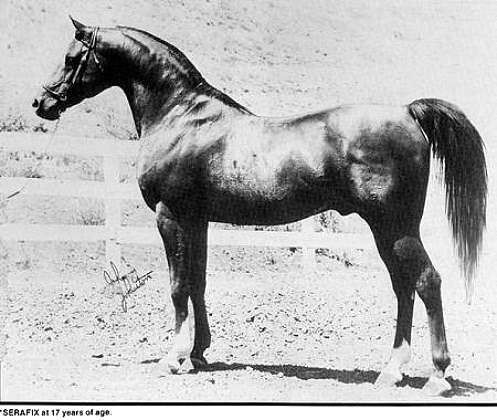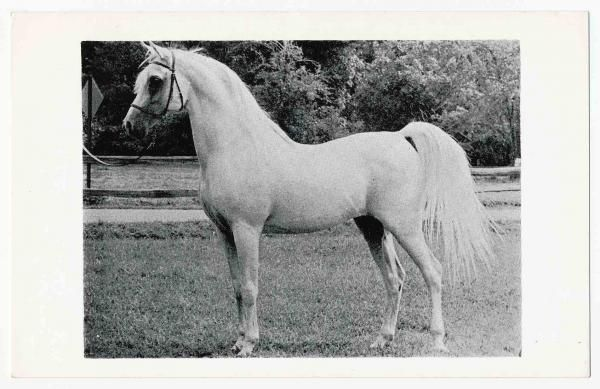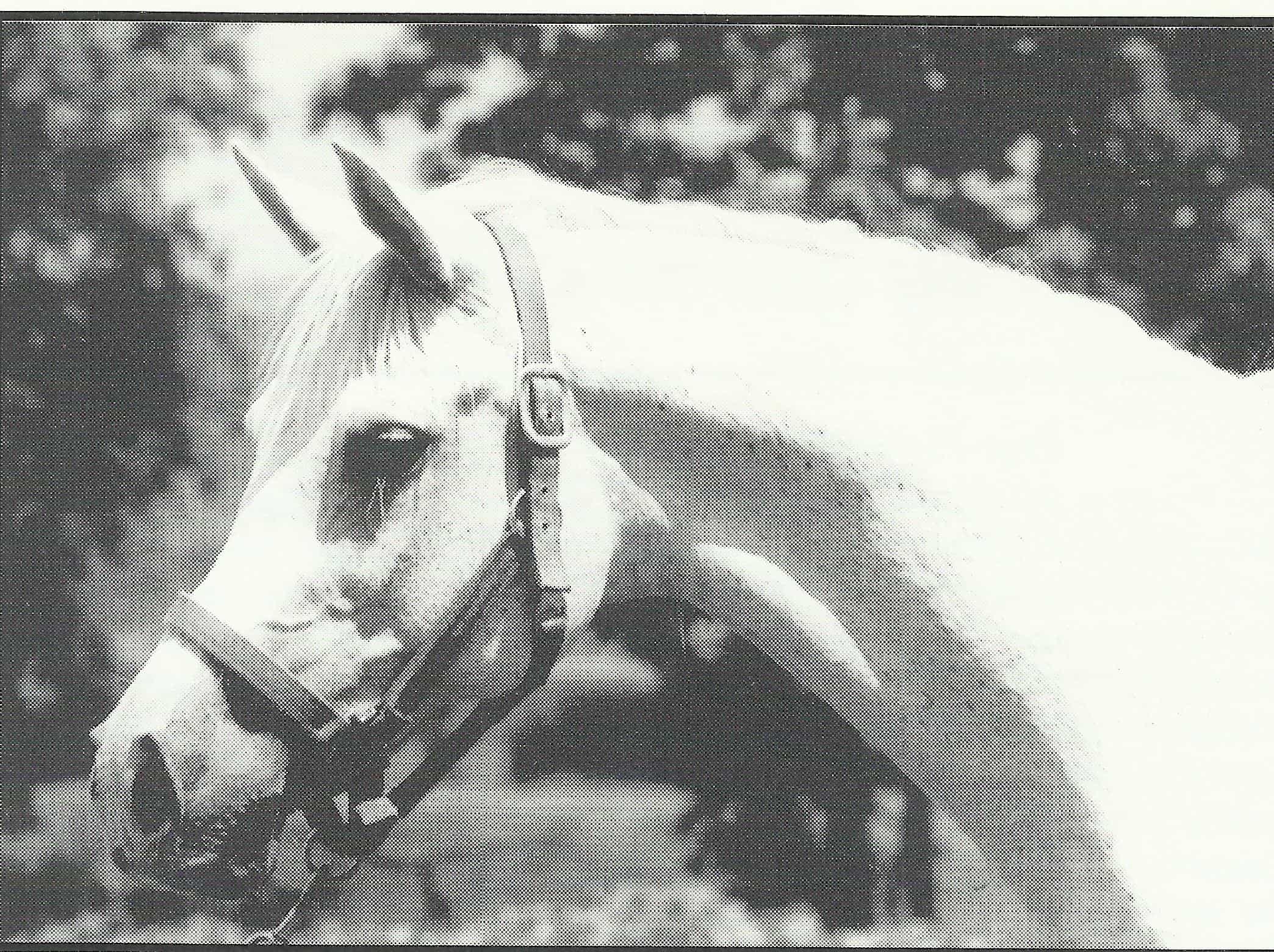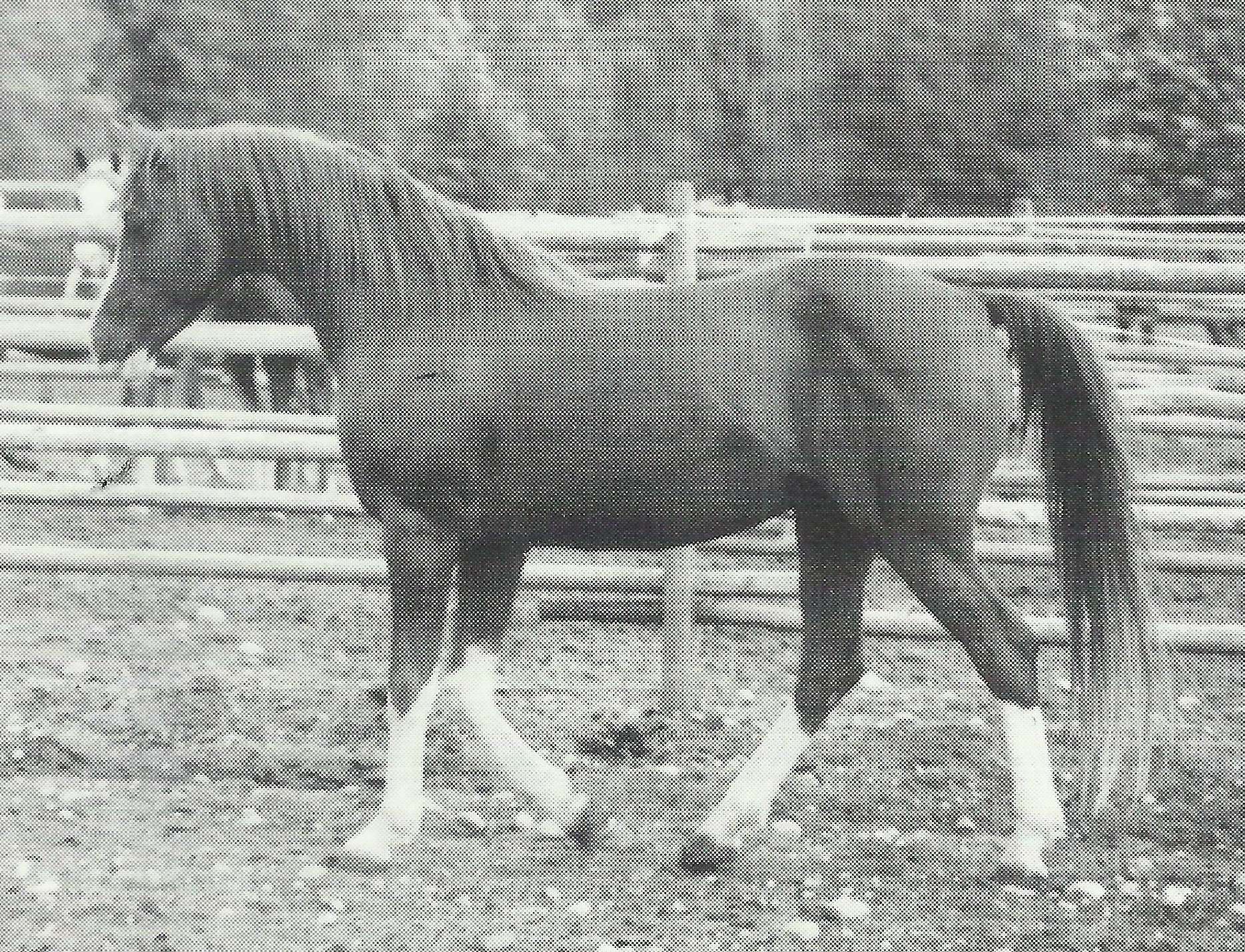By Georgia Cheer
** Originally published in the March 2000 issue of the Arabian Horse Times magazine, page 212.
Have you ever wondered what is so special about the Crabbet Arabian? Could it be their wonderful dispositions, their tractable minds or tremendous athletic ability, their prepotence for passing these characteristics through several generations, or that they excel in everything they are put to? Well, you could say that about nearly all Arabians, but here in the United States, Crabbet Arabians were some of the earliest and largest imports to our country, going back to 1893 when the bay stallion *Bedr 239 (Azrek x Bozra) was imported by W.H. Forbes. Altogether, about 145 Crabbet Arabians were brought to the U.S. from the years 1893 to 1976. So, what was the origination of the Crabbet Arabian?
The Early Beginnings of Crabbet Park Stud
Wilfrid Scawen Blunt and Lady Anne Isabella Noel King were married in London on June 8th, 1869. The Blunt family had been landowners in Sussex, in southern England, since the middle of the seventeenth century. Wilfrid and Lady Anne's early travels to the desert were made to seek "some of the true breed of Arab mares..."1
On December 14th, 1877, Lady Anne Blunt wrote in her journal: "We have made a plan...of importing some of the best Anazeh blood to England and breeding it pure there...it would be an interesting and useful thing to do and I should like much to try it."2 So, on Christmas Day in 1877, the Blunts were able to purchase their first mare, Dajania, in the desert city of Aleppo. By the following year, Crabbet Park Stud was founded by the Blunts.
Their desert acquisitions began to number and soon many horses were shipped back to the Crabbet Park grounds, near what is modern day Crawley, in Sussex. After generations of breeding Arabians, and selling their horses to many private breeders and foreign dignitaries, the Blunt's stock was soon carrying the Crabbet name and qualities throughout the world. The breeding program eventually passed onto the Blunts' daughter, Judith, better known to the world as Lady Wentworth, who is still to this day arguably the most intelligent and widely admired Arabian horse breeder of all time.
The First U.S. Importations
The first major importations to America were made by W.R. Brown of Maynesboro stud. He imported 18 Crabbet Arabians in 1918, although several individual breeders had imported one or two Crabbet Arabians earlier. In 1926, W.K. Kellogg purchased 16 Arabians from Crabbet Park Stud (including *Raseyn, half brother to *Raffles by Skowronek). Another significant importation came in 1930 when Roger Selby of Ohio brought nine Crabbet Arabians, one being the famous *Mirage.3
After the death of Lady Wentworth in 1957, Bazy Tankersley of Al-Marah Arabians purchased 16 Crabbet Arabians, which were imported later that year. Most of these Crabbet Arabians preceded the popular importations in the 1960s from Poland, the most notable Polish import being *Bask. *Bask received considerable success as a sire when put to Crabbet mares.
A Writer's Perspective
But in this article I will focus on three influential Crabbet stallions who were prepotent sires of champions: *Serafix, *Silver Vanity and *Raffles. These were the three Crabbet stallions, in my opinion, that have had the most influence on the breed, although there are so many other Crabbet stallions and mares who have also made their substantial mark. Each one of these three stallions was bred at Crabbet Park by the Right Honorable Lady Wentworth. (You can learn more about Crabbet Park Stud from the book The Crabbet Arabian Stud, It's History and Influence by Archer, Covey and Pearson. This book is a must for every Crabbet Arabian owner, and is quoted in this article.)
*Serafix 8955

The chestnut *Serafix 8955, was foaled in 1949. His sire was Raktha, and his dam Serafina. Raktha was a prominent sire at Crabbet, and was also the sire of Indian Magic, Rithan, and *Serafix's full brother, *Silver Drift. Serafina was also the dam of Oran Van Crabbet. *Serafix was imported in 1954 by John Rogers of Walnut Creek, CA.
*Serafix sired 119 champions, 41 of which were National winners from among his 257 registered foals, with a champion percentage of 46%. At one time, *Serafix was the leading sire of champions in the United States.
To quote Jim Panek, a Nationals judge and Arabian horse breeder, "*Serafix was truly a magnificent specimen. At that time I didn't know or care how good an Arabian he was; it was his magic, his charisma, his bloom, his attitude, his indescribable 'noblesse oblige' that, in my eyes, has yet to be duplicated. It was only later, after I became a more serious student of the breed, that I realized that, along with all of the things that tugged at one's heart, *Serafix was truly everything one could want in a breeding stallion. He was beautiful, typey, and refined. He had excellent conformation. He had so much quality that his skin was like tissue paper, and his veins showed through as if they were meant to be studied. He seemed a tall horse - with substance, masculinity, and power."4
*Serafix had an incredible impact on the Arabian breed, and this was because he sired so many champions from all the different bloodlines that were put to him, whether it be Polish, Egyptian, Russian or American. This is a true mark of a breeding stallion - that he can sire consistently and better than himself the majority of the time. *Serafix was known to have a fiery presence, and a regal, dynamic way of going that made an impression on all who saw him.
Some stallions sire better quality females than they do males, or maybe the reverse. It is not often that a stallion can sire outstanding quality of both sexes. It is always better, in my opinion, that a stallion sire better females to truly make a substantial contribution to the Arabian breed. This is because most stallions can only make their reputation by the quality of females they are allowed to serve. The mares that were bred to *Serafix were approved mares, as John Rogers did not stand *Serafix to outside mares. Serafix finally stood at public stud for only two years, from 1971 until his death in 1973.
*Serafix daughters have long held a reputation as outstanding broodmares. Some of the *Serafix daughters who have produced National winners include:5 Seranada, Jalana, Virginia Belle, SX La Quinta, Tisera, Chlosina, and Sarafina. Other *Serafix daughters who are credited for producing multiple champions are: SX Daphne, Serafilia, SX Suretta, Seraphima, Blue Angel, and Carinosa, the *Serafix daughter who is the dam of nine champions.
Several *Serafix daughters nicked particularly well with the Polish stallions *Karadjordje and *Bask and the Egyptian stallion, El Hilal. Others when bred to Khemosabi, *Padron and *Ansata Ibn Halima have produced champions.
Some of the sons of *Serafix who have sired National winners include: Nafix, Seraj, SX Saladin, Rakafix, Royal Gold, SX Conquistador, Ibn Chimena, Travaleer, Muskateer, SX Cantrez, Witezfix, Serad, Serasun, Royal Magic, Aseyr, Mystr-Fix and there are others. *Serafix's get dominated the show ring for many years, and they themselves went onto produce champions. His show impact is still relevant to this day.
I believe that there are one, maybe possibly even two, *Serafix sons still alive today. I had heard of one living in Idaho. It always amazes me to know that there are some living get of Crabbet legends still alive.
*Silver Vanity 22555

*Silver Vanity 22555, foaled in 1950, was imported by Bazy Tankersley and Charles Prange in 1962 (the same year Dr. H. F. Kale imported *Serafix's full brother, *Silver Drift 23494.) He was a gray son of Oran (Riffal x Astrella) x Silver Gilt (Indian Gold x Silver Fire). Oran was the principal stallion used after the second world war, and was actually bred by Hanstead stud out of entirely non-Skowronek blood. Silver Gilt (*Silver Vanity's dam) produced 13 registered foals in England, five of whom became British National Champions. From the Archer book: "Silver Gilt, one of the loveliest of Silver Fire's offspring, produced stock of the highest quality, of which the best was the unforgettable *Silver Vanity, who was considered by many to be one of the most beautiful stallions ever bred at Crabbet. He had all the qualities associated with the Silver Fire line, not least being his superlative head."6
*Silver Vanity's Worldwide Influence
*Silver Vanity was to make a profound mark not only on the U.S. Arabian breed, but also in both in Australia and in his native country of England.
*Silver Vanity was twice British National Champion in 1958 and 1962, and left 18 registered get in England prior to his importation to the U.S. In England, his son Hanif (x Sirella by Dargee) sired Haroun, who was Reserve Supreme Champion on three occasions before becoming Supreme Male Champion in 1974.
Hanif, when bred to his half sister Sirella, sired *Shatir AHS 305929, who went on to become an Israeli champion stallion before his U.S. importation. On this continent, he was 1984 Canadian Top Ten Stallion, and 1984 Top Ten Scottsdale stallion. I saw Shatir shortly after his arrival at the 1983 World Crabbet Symposium in Denver, CO. I remember him to be a tall, reachy liver chestnut stallion with a beautiful face and lovely movement.
Hanif's presence in the aged stallion class at the British Nationals was for years a tradition that many will remember, as he strutted and 'roared' his presence on the grounds, always to the admiration and applause of the crowds. I was fortunate enough to witness Hanif in this display at each British Nationals that I attended.
*Silver Vanity's daughter, Silver Ripple (x Risseefa), produced 1982 British Reserve National Champion Silver Flame, and Silver Vanity's son Shalwan (x Shalina) was Supreme Champion in South Africa.
In the United States, *Silver Vanity alternated stud seasons between Charles Prange's farm in Pennsylvania and Al-Marah, which was then located in Barnesville, Maryland. In 1970, he was sold to F. Lynn and Barbara J. Artress of California. They relocated to Georgia where *Silver Vanity died in 1979 at the age of 29.
*Silver Vanity sired 206 get in the U.S., 41 of which became champions. Some of his most notable daughters are: *Al-Marah Silver Silwa (x *Silwa) who was a halter champion; *Sharafa (x Sharfina) who produced six champions, notably *George Washington; *Silver Pearl (x *Perle D'or) a halter and English pleasure champion, and *Silvanetta, twice British Reserve National Champion (1962 British Reserve Champion Foal and 1963 British Reserve Junior Champion Female) who in turn produced three champions in America, including U.S. Top Ten Pleasure Driving Mare Baskanetta (by *Bask).
Other notable *Silver Vanity sons are: 1967 U.S. National Champion Western Pleasure horse Al Marah Silver Sparrow (x *Blue Millet); Royal Vanity (x Al-Marah Rallentando) who was 1973 Canadian Reserve National Champion Western Pleasure and Top Ten Native Costume; Vanity's Count (x Perihan Bint Dorsaz) was 1976 U.S. Top Ten Western Pleasure horse, and BL Majestic Gold (x Al-Marah Sola Mia) 1984 U.S. Reserve National Champion Native Costume.
Vanity's Count himself sired over 38 Class A Champions, 11 Regional Top Fives, and for years was the leading sire of winners at the Ohio Buckeye show. Royal Vanity went onto sire 1983 US Reserve National Champion Western Pleasure JOTR RV Golden Vanity. The Silver Vanity son Indian Silver (x *Taheki), sired 1984 U.S. Top Ten Informal Combination and Pleasure Driving BL Indian Velvet.
Although I never saw *Silver Vanity in person, I've had the privilege to own one of his daughters. This wonderful mare produced two foals for me, always produced better than herself, and passed down the unique elegant qualities known in the Silver line.
I did have the good fortune to see several Sindh (*Silver Vanity x Silfina) sons during my visit to Australia in 1991. They were remarkably similar and of good quality. Sindh sired more purebreds than any other horse in Australia at that time, a record he may still hold. Through Sindh alone, Silver Vanity's influence in Australia will never be outlived.
There is little to dispute that *Silver Vanity was one of the finest stallions ever imported to America.
*Raffles 952

*Raffles 952, foaled in 1926, was imported by Roger Selby in 1932. (*Raffles is also pictured at the top of page as the header/article photo) *Raffles is considered one of the most important stallions ever to come to the United States. His prepotence was due to the fact that he was inbred, a product of his sire, Skowronek put to his own daughter, *Rifala.
Inbreeding often leads to a loss in size, but it also tends to concentrate the best features (and sometimes worse) of an individual. In *Raffles case, he stood 13.3 hands while his dam *Rifala was 13.2. His prepotence to pass on his inbred qualities made him a highly successful sire.
*Rifala was a daughter of Rissla, a chestnut Crabbet broodmare whose success included two sons: the beautiful Irex, and the action sire Rissalix; and her daughter Risslina (granddam of Abu Farwa). Rissla was double Mesaoud and inherited action from her sire *Berk, who was famous for his outstanding trotting ability.
Skowronek, the sire of *Raffles, was a cornerstone sire of the Arabian breed and considered quite prepotent as a sire. Although Skowronek was bred by Count Jozef Potocki's Antoniny Stud in Poland, it wasn't until Lady Wentworth obtained him at age 12 and used him on her Crabbet mares that his breeding reputation was made.
But *Raffles didn't start out as a successful sire, in fact, he was sold from Crabbet Park because he proved sterile. He was still sterile for five years after arriving at Selby's. It was Mr. Selby's stud manager, Jimmy Dean, who is credited for reviving Raffles fertility at the age of 11, primarily through the use of exercise.
*Raffles sired horses of beauty, particularly in the head, with overall refinement, good movement (some were brilliant movers), and very good dispositions. His get were not usually known for their size, but many were taller than their sire. Often their one drawback was that they tended to lack defined withers.
*Raffles blood nicked well with many other Arab bloodlines. However in the U.S., there were many breeders who carried on intensely linebreeding *Raffles. Many times *Raffles was put to *Mirage daughters (another Crabbet stallion that was imported by Roger Selby and had enormous influence on the breed), and *Mirage to *Raffles daughters, producing some of the breed's best quality Arabians.
*Raffles blood is still a very positive influence through pedigrees to this very day. Several well established breeding herds have intense *Raffles bloodlines: Al-Marah Arabians, William Munson's Shalimar Arabians, Dr. Robert Dryden's Fable Arabians, and so many more. There is a strong group of Azraff/Ferzon breeders carrying on this cross.
Raffles sired 61 sons and 62 daughters, a total of 123 get. Most of his get had enormous influence themselves in either the show ring or in the breeding barn, and are much too numerous to mention individually. Some of his best known sons are: Geym 2363 (x Rageyma) a very successful son; Indraff 1575 (x *Indaia) the foundation sire for Al-Marah Arabians; Aarief 3717 (x Aarah) a foundation sire for Lasma Arabians; Rasraff 2365 (x *Rasmina) who did well as a stock horse; Sotep 8385 (x Zareyna) a very popular sire; Rapture 3783 (x Rafla); Handeyraff 3940 (x Hanadina); Azraff 5596 (x *Azja IV) one of his best known sons and Tut Ankh Amen 3830 (x *Roda).
Some of his best known daughters are Cassandra 3831 (x Rodetta); My Bonnie Nylon 3832 (x Joharah); Rose Marie 4168 (x Rodetta), Aarafa 2872 (x Aarah), Flaia 3378 (x *Indaia) and Scheraffa 3938 (x Scheherazade).
*Raffles survived a broken leg in 1949 at age 23, and after his recovery, was sold to Alice Payne of Whittier, CA. *Raffles died May 11, 1953 at the age of 27.
I had the privilege of owning the *Raffles granddaughter Mira Raffa, sired by Mraff, a multi-champion park horse son of *Raffles. She was a prolific broodmare, had the bravado bold trot of her sire, and the beautiful white coloring of her grandsire *Raffles. Her disposition was the trademark of many *Raffles horses, sweet, good natured and easy to handle. She was a comfortable ride and produced several wonderful foals for me.
*Raffles, the small inbred son of Skowronek, made a huge contribution to the success of the Arabian breed in this past century.
As you can now see, the Crabbet lines are still very predominant in today's champions pedigrees, usually in the tail female line. These lines successfully passed qualities of Arabian type and performance. I hope you can now begin to realize the tremendous impact and value of the Crabbet Arabian Stud. These Crabbet Arabians and so many others are the cornerstone of our fine American Arabian heritage.
For further and in-depth history on many of the early Crabbet breeders and influential Crabbet horses, please read back issues of The Crabbet Influence magazine.
Footnotes:
1-Archer, Pearson, Covey, "The Crabbet Arabian Stud, Its History and Influence" (Irthingborough: Alexander Heriot & Co. Ltd, 1994) page 33.
2-Archer, page 33.
3-Carol Mulder, "The W.K. Kellogg Arabians Horse Ranch Part II, Crabbet Background," The Crabbet Influence in Arabians Today, January-February 1987: page 13.
4-Jim Panek, "Serafix Remembered," The Crabbet Influence in Arabians Today, March-April 1986.
5-Arlene Magid, "Serafix: Premier Crabbet Broodmare Sire" The Crabbet Influence in Arabians Today, March-April 1986, and, Arlene Magid, "The Sons of Serafix" The Crabbet Influence in Arabians Today, May-June 1986.
6.-Archer, page 187
**All of the articles included in the re-launched Crabbet.com site from the original website, Georgia Cheer, Silver Monarch Publishing and The Crabbet Influence magazine are shared here with permission of Georgia Cheer given May 16, 2012.**
Last Updated: April 13th, 2019




Comments
No Comments